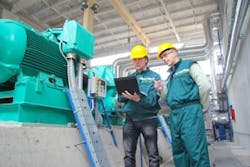I recently presented at a conference that focused on condition-based maintenance. The invitation was somewhat of a surprise as it came on the heels of another speaker’s unexpected cancellation. I’ve long known that a key part of my job is to evangelize and not worry how I get put in front of any particular audience. Besides, I knew I had two aces up my sleeve with this particular event: one, the event was co-hosted by two of my company’s more prominent partners, who were thrilled that the agenda remained filled. And two, a key customer allowed me to share data that highlighted an unsung benefit of effective PID control: It enhances reliability.
It seems as though most discussions concerning condition-based maintenance quickly shift toward asset reliability and predictive analytics. There’s quite a bit of value to be gained from monitoring the health of large rotating equipment. What’s more, predictive technologies have been a hot topic particularly in the past decade. Still, what’s frequently overlooked is both the number of other, “lesser” assets that also play a role in plant uptime and the tools that are proving helpful in managing these. For a variety of reasons, both technical and economic in nature, most of those lesser assets – pumps, motors, heat exchangers, and the like – are not monitored by predictive technologies .But their vital signs are contained in a plant’s PID controller data.
The PID is used to regulate process performance at most every production facility. It’s a relatively simple feedback technology that has proved very reliable in industry. Essentially, the PID computes the amount of error found in a process signal and corrects for the error by signaling adjustments to a final control element (FCE) .An interesting thing about a well-tuned PID is that it requires FCEs like valves and dampers to work less. Said another way: Good PID control eliminates excess activity that can accelerate wear and tear. Indeed, data that my customer supplied showed that improved PID control reduced wear and tear by an average of 51%.
Here’s how well-tuned PID controllers improved reliability of one process manufacturer’s many lesser assets in a typical process plant:
- Less overshoot – Compared with poorly tuned controllers, well-tuned PIDs responded to disturbances with less overshoot. As a result, they were able to correct for disturbances and return to set points faster. Because fewer adjustments were required, the well-tuned PID limited the amount of work performed by the FCEs.
- Less oscillation – Unlike poorly tuned PIDs, the well-tuned controllers were more effective at curbing oscillations and unstable process behavior that forced FCEs to open and then close in seemingly nonstop fashion. By demanding less action, the well-tuned PIDs put the brakes on their FCEs' steady march toward MTBF.
- Less interaction –The plant’s processes were highly interactive. Each control loop influenced others located throughout the plant (whether directly or indirectly). Indeed, unnecessary variability associated with poorly tuned loops affected more than just downstream processes; it forced those PIDs to constantly correct for error, which increased FCE wear and tear.
- Less maintenance – When FCEs weren’t being overworked, they required less attention from maintenance staff and less-frequent replacement. That translated into significant cost savings as the plant invested less in replacement assets and spent more time on optimization. It also resulted in significant productivity gains as the plant experienced less downtime.
For quite some time, process manufacturers have focused on complex, predictive technologies to improve the reliability of large rotating equipment. While that approach to condition-based maintenance has proved successful, it has largely overlooked assets of lesser perceived value. If you consider that a typical production plant has many, many more valves and dampers than turbines and centrifugal pumps, then it seems logical that the view of condition-based monitoring should be broadened. Keep in mind: When those lesser assets fail, production still comes to a halt.
An easy way to expand the scope and value of condition-based maintenance is to examine data associated with a plant’s many PID controllers. By including basic analysis of PID control-loop performance, a plant’s maintenance and engineering staff can quickly realize significant gains in asset reliability. If you are considering ways to enhance your plant’s condition-based maintenance effort, then these other posts may be of interest:


